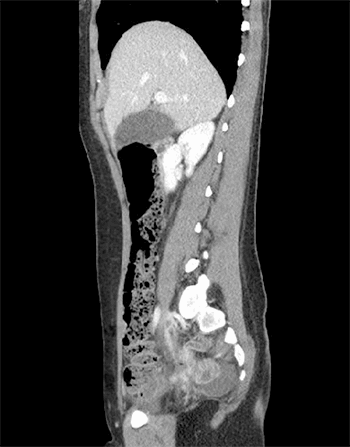Conclusion
Delayed complications from retained intrathoracic foreign bodies are rare events that may result in hemoptysis, pneumonia, or empyema. The strategy for foreign body retrieval in symptomatic patients depends on the degree of endobronchial erosion during bronchoscopic evaluation, with judicious use of preprocedural angioembolization of collateral bronchial vessels in patients at high risk for vascular involvement.11
Lessons Learned
Delayed complications from retained intrathoracic foreign bodies are rare due to scarring and their fixed position after the initial postinjury period, making their management complex. We have developed a clinical management algorithm to help clinical decision making.
Authors
Ahmed Khouqeer, MD
Baylor College of Medicine
Ben Taub Hospital
Department of Cardiothoracic Surgery
Houston, TX
Peter C. Chen, MD
Baylor College of Medicine
Ben Taub Hospital
Department of Cardiothoracic Surgery
Houston, TX
Hart Donahue, MD
Baylor College of Medicine
Ben Taub Hospital
Department of Cardiothoracic Surgery
Houston, TX
Andres Espinoza, BS
Baylor College of Medicine
Ben Taub Hospital
Department of Cardiothoracic Surgery
Houston, TX
Ravi Ghanta, MD
Baylor College of Medicine
Ben Taub Hospital
Department of Cardiothoracic Surgery
Houston, TX
Kenneth Mattox, MD
Baylor College of Medicine
Ben Taub Hospital
Department of Cardiothoracic Surgery
Houston, TX
Matthew Wall, MD
Baylor College of Medicine
Ben Taub Hospital
Department of Cardiothoracic Surgery
Houston, TX
Correspondence
Andres Espinoza, MD
Baylor College of Medicine
Baylor Plaza
Houston, TX 77030
Phone: 248-250-0589
E-mail: andres.espinoza@bcm.edu
Disclosures
The authors have no conflicts of interest to disclose.
References
- Saunders MS, Cropp AJ, Awad M. Spontaneous endobronchial erosion and expectoration of a retained intrathoracic bullet: case report. J Trauma. Dec 1992;33(6):909–911.
- Voskuil M, Overtoom, TC, Schramel FM. Hemoptysis Resulting From Endobronchial Migration of a Bullet 10 Years After Chest Injury. J Bronchol. 2005;12(4):222–224.
- Bland EF, Beebe GW. Missiles in the heart. A twenty-year follow-up report of World War II cases. N Engl J Med. May 12 1966;274(19):1039–1046.
- Hesami SM, Johari HG. Spontaneous expectoration of an asymptomatic retained intrathoracic bullet. Injury. Jul 2012;43(7):1219–1221.
- Leslie RM. Spontaneous Evacuation of a Shrapnel Bullet in the Lung by Expectoration. Br Med J. Nov 17 1917;2(2968):648–649.
- Agha RA, Fowler AJ, Saetta A, Barai I, Rajmohan S, Orgill DP, for the SCARE Group. The SCARE Statement: Consensus-based surgical case report guidelines. Int J Surg. 2016;34:180–186.
- Kovnat DM, Anderson WM, Rath GS, Snider GL. Hemoptysis secondary to retained transpulmonary foreign body. Diagnosis by fiberoptic bronchoscopy 28 years after injury. Am Rev Respir Dis. Feb 1974;109(2):279–282.
- Kelley WA, James EC. Retained intrapulmonary bullet presenting with bronchial obstruction. J Trauma. Feb 1976;16(2):153–154.
- Bogedain W. Migration of schrapnel from lung to bronchus. JAMA. Apr 13 1984;251(14):1862–1863.
- Boomer LA, Watkins DJ, O'Donovan J, Kenney BD, Yates AR, Besner GE. An unusual case of foreign body pulmonary embolus: case report and review of penetrating trauma at a pediatric trauma center. Pediatr Surgery Int. Mar 2015;31(3):241–247.
- Alexander GR. A retrospective review comparing the treatment outcomes of emergency lung resection for massive haemoptysis with and without preoperative bronchial artery embolization, Eur J Cardiothoracic Surg. 2014;45:251–255.



